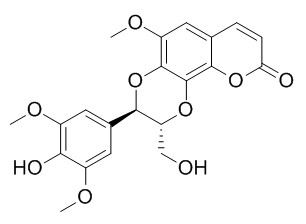Cleomiscosin C
Cleomiscosin C has antioxidant activity, it protects against the oxidative modification of apoB-100 induced by either Cu2+ or HOCl ( IC50s of 23.6 and 3.9 microM, respectively), suggests that it could be beneficial in preventing LDL oxidation in atherosclerotic lesions. Cleomiscosins A, B and C exhibit liver-protective properties.
Inquire / Order:
manager@chemfaces.com
Technical Inquiries:
service@chemfaces.com
Tel:
+86-27-84237783
Fax:
+86-27-84254680
Address:
1 Building, No. 83, CheCheng Rd., Wuhan Economic and Technological Development Zone, Wuhan, Hubei 430056, PRC
Providing storage is as stated on the product vial and the vial is kept tightly sealed, the product can be stored for up to
24 months(2-8C).
Wherever possible, you should prepare and use solutions on the same day. However, if you need to make up stock solutions in advance, we recommend that you store the solution as aliquots in tightly sealed vials at -20C. Generally, these will be useable for up to two weeks. Before use, and prior to opening the vial we recommend that you allow your product to equilibrate to room temperature for at least 1 hour.
Need more advice on solubility, usage and handling? Please email to: service@chemfaces.com
The packaging of the product may have turned upside down during transportation, resulting in the natural compounds adhering to the neck or cap of the vial. take the vial out of its packaging and gently shake to let the compounds fall to the bottom of the vial. for liquid products, centrifuge at 200-500 RPM to gather the liquid at the bottom of the vial. try to avoid loss or contamination during handling.
Int J Oncol.2016, 49(4):1497-504
Saudi Pharmaceutical Journal2023, 31(12):101829
Separations2021, 8(6),80.
LWT-Food Science and Technology2017, 75:488-496
Am J Chin Med.2023, 51(4):1019-1039.
Phytomedicine.2015, 22(4):498-503
Plants (Basel).2021, 10(5):951.
Aging (Albany NY).2021, 13(19):22867-22882.
Drug Chem Toxicol.2020, 1-12.
Int J Mol Sci. 2014, 15(5):8443-57
Related and Featured Products
Arch Pharm Res. 2007 Mar;30(3):275-81.
Antioxidant activity of cleomiscosins A and C isolated from Acer okamotoanum.[Pubmed:
17424931]
Phytochemical investigation of Acer okamotoanum leaf and twig led to the isolation of two coumarinolignans, cleomiscosin A (1) and Cleomiscosin C (2).
METHODS AND RESULTS:
Here, we found that 2 dose-dependently inhibits LDL oxidation mediated by either catalytic copper ions (Cu2+) or free radicals generated with the azo compound 2,2'-azobis-(2-amidinopropane)dihydro-chloride (AAPH) with IC50s of 29.5 and 11.9 microM, respectively. By electrophoretic analysis, we also observed that Cleomiscosin C protects apolipoprotein B-100 (apoB-100) against Cu2+-induced fragmentation (65.3% inhibition at 5 microM). Furthermore, fluorescence analyses clearly indicated that both 1 and 2 protect against the oxidative modification of apoB-100 induced by either Cu2+ or HOCl (1, IC50s of 13.4 and 8.1 microM, respectively; 2, IC50s of 23.6 and 3.9 microM, respectively).
CONCLUSIONS:
These findings suggest that 1 and Cleomiscosin C could be beneficial in preventing LDL oxidation in atherosclerotic lesions.
J Nat Med. 2011 Jan;65(1):191-3.
Aromatic compounds and their antioxidant activity of Acer saccharum.[Pubmed:
20686865]
METHODS AND RESULTS:
A new lignan glycoside, 5-(3″,4″-dimethoxy-phenyl)-3-hydroxy-3-(4'-hydroxy-3'-methoxybenzyl)-4-hydroxymethyl-dihydrofuran-2-one 4'-O-α-L: -rhamnopyranoside (1), with seven known compounds, compound 2, koaburside, icariside E(4), Cleomiscosin C, cleomiscosin D, scopoletin, and 5'-demethylaquillochin, were isolated from the EtOH extract of the wood of Acer saccharum (Aceraceae). Their structures were determined by 1D and 2D nuclear magnetic resonance (NMR) and mass spectroscopy analysis. All of the isolated compounds, 1-8, were tested for their antioxidant activity in superoxide dismutase (SOD)-like assay.
Tetrahedron, 1985, 41(1):209-14.
Structures of cleomiscosins, coumarinolignoids of cleome viscosa seeds.[Reference:
WebLink]
METHODS AND RESULTS:
Structures of cleomiscosin A, cleomiscosin B and Cleomiscosin C, three new coumarino-lignoids isolated from the seeds of Cleome viscosa Linné, have been established as 1a, 2a and 1f irrespectively, on the basis of spectral and chemical evidence.
CONCLUSIONS:
The compounds exhibited liver-protective properties.



